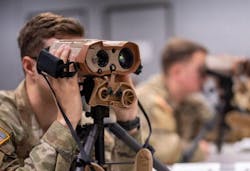Safran to build more laser target locator electro-optics systems for SwAP-conscious Army infantry warfighters
ABERDEEN PROVING GROUND, Md. – U.S. Army land warfare experts are asking electro-optics engineers at Safran Optics 1 Inc. in Bedford, N.H., for additional next-generation laser target locator systems.
Officials of the Army Contracting Command at Aberdeen Proving Ground, Md., announced a $275 million contract to Safran in September to build Laser Target Locator Module II (LTLM II) systems. A laser target locator enables foot soldiers identify target locations in daylight or at night, as well as in obscured-visibility such as fog or smoke.
The LTLM II is a lightweight handheld laser target locator with a color day camera and night sight, and a selective availability anti-spoof module (SAASM) Global Positioning System (GPS) receiver. The contract includes spare parts and maintenance.
LTLM II is a second-generation lightweight handheld laser target locator with a direct view optic, uncooled thermal camera, low-light camera, eye-safe laser range finder, digital magnetic compass, and a selective availability anti-spoofing module GPS receiver.
It provides infantry forward observers, scouts, snipers, and platoon leaders all-weather capability to locate targets and transmit target data. With LTLM II, Soldiers can determine a target location in seconds. In 2021 Safran delivered the 4,000th LTLM II to the Army.
The LTLM II is smaller and more affordable than previous laser targeting systems, such as the lightweight handheld Laser Target Locator Module (LTLM), which is being manufactured by the BAE Systems Electronic Systems segment in Hudson, N.H.
The Army awarded BAE Systems a $23 million contract to the provide the LTLM in February 2012. The company is providing the company's Target Reconnaissance Infra-Red Geolocating Rangefinder, or TRIGR, which helps soldiers determine target coordinates quickly and accurately.
For LTLM II, however, Army officials say weight is an crucial factor. The goal for this next-generation laser rangefinder is to reduce the system's size, weight and power (SWaP) consumption while decreasing its cost. Safran won its original LTLM II contract in July 2016.
Related: Probing what the human eye cannot see
Among the laser targeting products from Safran is the company's Handheld Precision Targeting Device (HHPTD) -- a lightweight, multi-functional, integrated sensor that provides accurate target coordinates for precision target engagement.
The multispectral device delivers precision target coordinates by using several north-finding solutions and displays a 90-percent target location error measurement in the bi-ocular eyepiece, Safran officials say.
The field-proven HHPTD system provides precision target measurements and long-range observation capability in day or night and under all-weather environments.
For more information contact Safran Optics 1 online at https://www.safran-group.com/companies/optics-1-inc, or the Army Contracting Command-Aberdeen at http://acc.army.mil/contractingcenters/acc-apg.
About the Author
John Keller
Editor-in-Chief
John Keller is the Editor-in-Chief, Military & Aerospace Electronics Magazine--provides extensive coverage and analysis of enabling electronics and optoelectronic technologies in military, space and commercial aviation applications. John has been a member of the Military & Aerospace Electronics staff since 1989 and chief editor since 1995.
